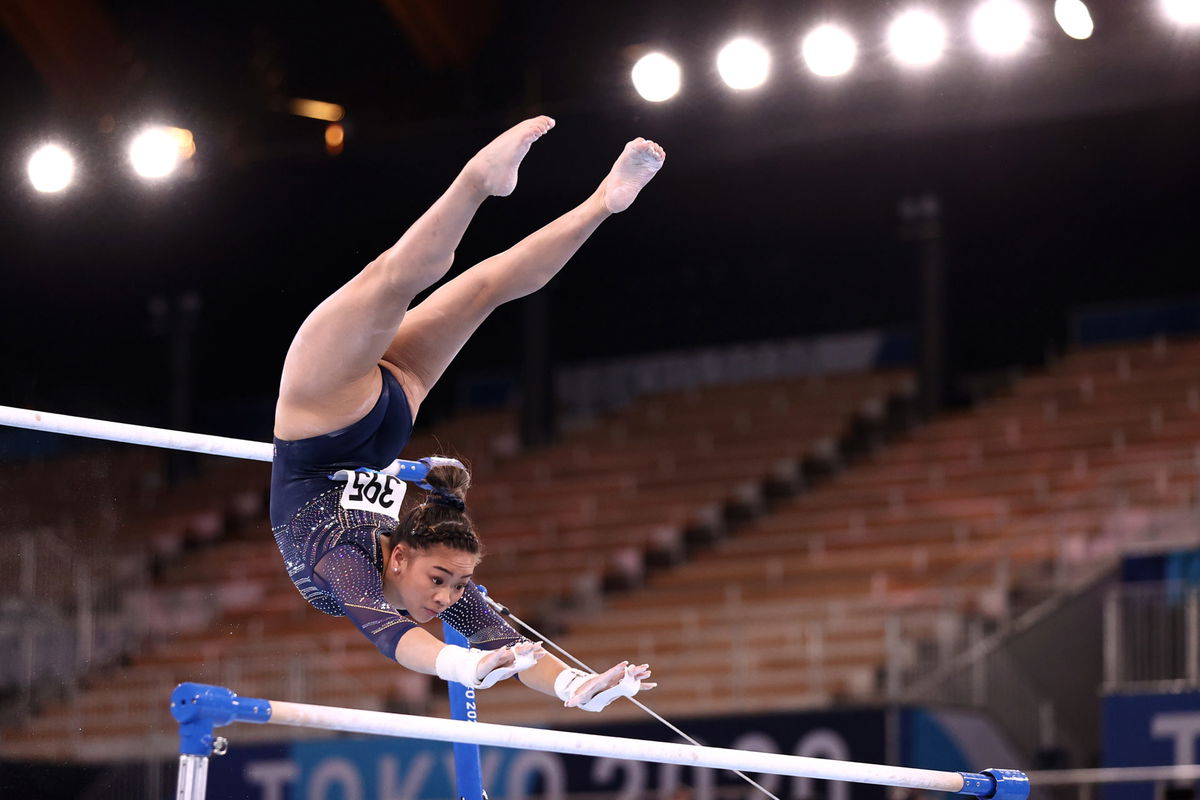
Getty
TOKYO, JAPAN – AUGUST 01: Sunisa Lee of Team United States competes in the Women’s Uneven Bars Final on day nine of the Tokyo 2020 Olympic Games at Ariake Gymnastics Centre on August 01, 2021 in Tokyo, Japan. (Photo by Maja Hitij/Getty Images)

Getty
TOKYO, JAPAN – AUGUST 01: Sunisa Lee of Team United States competes in the Women’s Uneven Bars Final on day nine of the Tokyo 2020 Olympic Games at Ariake Gymnastics Centre on August 01, 2021 in Tokyo, Japan. (Photo by Maja Hitij/Getty Images)
For an onlooker, gymnastics is just a sport of mesmerizing rhythmic exercises that demand flexibility, balance, and strength. However, for the gymnasts, it is more than just some effortless eye-pleasing exercise routine. As simple as it may appear to be to the audience, nothing about the sport is simple. Every single move, as uncomplicated as it may look, needs to be carried out without utmost precision and caution. There is no room for mistake here, as a single wrong footing can cause life-altering damage to the athlete.
Watch What’s Trending Now!
Furthermore, there are some moves, which were once performed by the veterans, that are now banned in the sport. There are various reasons why a move could be prohibited it. At times, it is because of the complexity and risk involved, other times it may be because a move has been overused by the participants. However, there are consequences if one chooses to perform banned moves in the competitions.
ADVERTISEMENT
What happens when you do a prohibited gymnastics move?
Breaking a rule always comes with a price when caught. Similarly, if someone chooses to break a rule in the gymnastics competition by carrying out a banned routine, naturally, they’ll have to face the consequences. These consequences can be as simple as a negative marking and as dire as disqualification. However, there are no legal repercussions involved and the performing athlete won’t end up in jail.

Getty
TOKYO, JAPAN – JULY 25: Sunisa Lee of Team United States competes on uneven bars day two of the Tokyo 2020 Olympic Games at Ariake Gymnastics Centre on July 25, 2021 in Tokyo, Japan. (Photo by Laurence Griffiths/Getty Images)
However, this raises yet another question. What are the different denouements? There may be the following results from such situations.
ADVERTISEMENT
? Negative Scoring – In case a gymnast opts to carry out a banned skill in his/her routine, the judge has the liberty to deduct some points from their score. This might be in cases where the skill is unknown to the judge., i.e. not mentioned in the rule book, or it is carried out incorrectly. However, no points are allotted in case a banned move is carried out correctly.
Top Stories
Greg Biffle’s $4M Worth Prized Possession Still Without a Buyer Leaves NASCAR Fans Heartbroken

LIV Golf Braces for Another Possible Exit in Wake of Brooks Koepka Departure

Sean Payton Announces Retirement Plans as Broncos HC Demands Improvement From Bo Nix & Co. Before Playoffs

Biff Poggi All But Confirms Bryce Underwood’s Michigan Future After Announcing His Own Departure

Roger Federer Draws Criticism from Swiss Government Chief for Tourism Boom in Country

Amanda Balionis Confirms New Relationship Ending Months of Rumors

? Zero Score – Performing an illegal move such as the vault can lead to the score of the entire routine being reduced to zero (0).
ADVERTISEMENT
All the moves that are allowed to be performed in the contests have been listed by the FIG in the 2022-2024 Code of points a.k.a. their rulebook. Although the sport is all about pulling off stunts with precision, several situations can lead to a move being banned.
ADVERTISEMENT
Why are some moves banned in gymnastics?
While gymnastics is one of the most aesthetically pleasing sports, there have been instances when the competitors have gone above and beyond in the competitions or not gone far enough. This has led to the FIG banning some of the moves in the contests. Following are the reasons why some moves were banned in the history of gymnastics:

Reuters
Simone Biles of the U.S competes on the beam during the women’s all-round final at the World Gymnastics Championships at the Hydro Arena in Glasgow, Scotland, October 29, 2015. REUTERS/Phil Noble
? Aesthetics – As mentioned above, gymnastics is a sport that is based on aesthetics, precision, rhythmic and artistic movements. There are times when some moves or routines do not suit the aesthetics of the apparatus. To avoid such situations, some moves were banned from being performed in the contests.
ADVERTISEMENT
? Safety – The common reason behind most of the banned moves is safety. As we already know, there is no room for mistakes in this sport. This is because a single mistake or miscalculation can lead to permanent physical damage or worse. In the past, there have been gymnasts who sustained injuries that left them partially or completely paralyzed for the rest of their lives.
? Difficulty – Another reason why a move can be banned is because of the level of its difficulty. In the past, some moves have been banned because, even though some athletes were able to perform them effortlessly, others were not. Hence, the moves were deemed too difficult. The most recent example of this case was seen in 2019 when a move performed by the gymnastics GOAT Simone Biles was banned.
Most of the moves have been banned because of the risk involved or the accidents they have caused.
ADVERTISEMENT
What are the moves that are banned in gymnastics?
Given below is a list of some of the moves that were banned to ensure the safety of the gymnasts.
? The Dead loop:? Also known as the Korbut flip, was named after the Olympics gold medalist, Olga Korbut. Though Koburt successfully performed at the 1972 Olympics, it was banned in 1985. It happened after the FIG Code declared it illegal to stand on the high bar. This move required the performer to stand on the high bar followed by a backflip to hold the high bar while stretching the body to the lower bar.
ADVERTISEMENT
1972. The banned "Dead Loop" of Olga Korbut. pic.twitter.com/3Q2J4RyBvT
— A SLICE OF HISTORY (@asIiceofhistory) August 30, 2022
? Standing dismounts: Along with the dead loop, the standing dismounts were also banned when it became illegal to stand on the high bar. After the high bar rule was released, gymnasts tried to carry out the standing dismounts on the low bars. This proved to be even more dangerous. Therefore, to avoid unforeseen deadly situations, the standing dismounts were completely removed, irrespective of the height of the bar.
https://twitter.com/intlgymnast/status/1362957999699091458?s=20&t=hQByH-VyDgo8z4aREkh9qQ
ADVERTISEMENT
? Thomas Saltos:?Named after the famous male gymnast, Kurt Thomas, this move was banned from female gymnastics more than three decades ago. A definitive stand was taken against the skill a decade after the famous gymnast Elena Mukhina broke her neck while performing the move. Following the incident, Mukhina was paralyzed in all four limbs (quadriplegic).
Felipe Andres (SUI), 1990 Dutch Open MAG AA. He finished his exercise, and reason no. 861 why Thomas Saltos are banned. pic.twitter.com/Na6vOWqhwh
— Matt Esler (@MattEsler) January 23, 2020
Other skills banned by the Federation include the Mukhina Flip, Quad Series, all kinds of rollouts, curtain vaults, etc.
Conclusion
These moves have been banned to ensure the safety of the gymnasts. However, over the years athletes and coaches have found a way around the bans to perform these moves in contests. This often leads to a negative marking or zero score in case the judges are able to draw the parallels.
Watch This Story: Olympic Legends Simone Biles, Michael Phelps and Katie Ledecky Hangout with Gold Medals Around Their Neck
What do you think about these moves and the ban on them? Do you think the ban was necessary to safeguard the athletes or does it restrict the freedom of the sport?
ADVERTISEMENT
ADVERTISEMENT
ADVERTISEMENT

